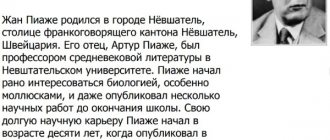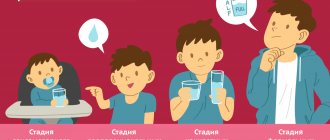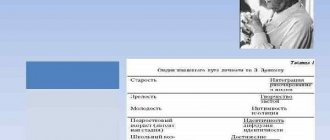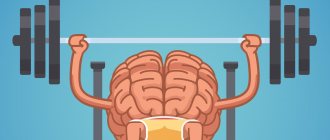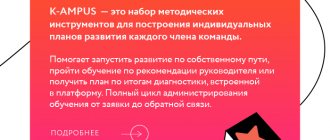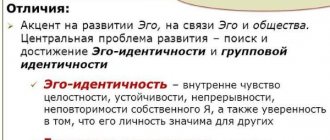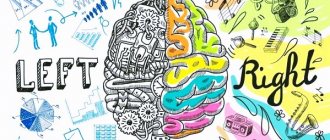How does our ability to think logically and clearly develop? What happens in the child's brain as the child acquires the skills of understanding and awareness of the phenomena of the surrounding reality? In other words, what is hidden behind the process of cognitive development, and what is it even?
Let's take a closer look at this concept and consider the features of the development of thought processes in human beings. In this article we will introduce you to the main phenomena and milestones of cognitive development, as well as to one of the leading theorists in this field - Jean Piaget, and the stages he identifies in this important process.
In this article we will focus on the first two such stages, and in the next article we will continue the topic. There we will also indicate some practical ways and recommendations for parents who would like to help their child with his cognitive development.
So, first let's define what is meant by this term and what factors are important here.
What is cognitive development
The study of cognitive development has made it possible to take a step in understanding the psychological health of children and adolescents.
Thought processes are necessary to interact with the world around us. As they grow older, they improve, which allows the child, and then the teenager, to interact with the external environment. This change, which occurs constantly, is called cognitive development. The criteria for its evaluation are:
- memory;
- perception;
- the ability to think in categories, set goals and achieve them;
- logics;
- imagination.
Features of the development of Jean Piaget
The theory of cognitive development was developed by Jean Piaget, the famous Swiss psychologist and philosopher. It concerns the improving abilities of children from birth to 15 years. The scientist believed that a child’s thinking differs from the mental capabilities of an adult. It's not just about experience and worldly wisdom. The quality of thought processes differs. At the same time, he highlighted the characteristics of children’s intellectual abilities:
- The ability to judge an object or phenomenon based solely on one’s own thoughts and experience. For a child there is no other point of view;
- The tendency to perceive events taking into account only the outcome. Children do not pay attention to intentions, the influence of additional factors, they take into account final manifestations, what they see;
- The habit of animating moving objects, for example, clouds, a train;
- Treat existing objects and phenomena as created by people;
- Lack of logical connection between conclusions.
A child's cognitive intelligence develops through several successive stages. Some abilities replace others and develop. At the same time, the highest degree of perfection is achieved by the age of 15.
Assessment of psychomotor and speech development of infants and toddlers (developmental assessment)
In essence, the emergence of a particular skill in a baby is the formation of an acquired reflex. And it can be formed only after the brain structure responsible for this reflex has matured. No structure - no skill. That is why pediatricians can assess the degree of maturation of various parts of the brain by the presence or absence of relevant skills.
The emergence of a particular skill in a baby is the formation of an acquired reflex.
You can evaluate the psychomotor and speech education of a baby at home. To do this, we present below the main points when assessing psychomotor and speech education, and also indicate the average time for the appearance of a particular skill in healthy children:
Motor - static:
- Holds head (2 months);
- Rolling onto the stomach from a supine position (4-5 months);
- Rolling onto your back from a prone position (5-6 months);
- Sitting (6 months);
- Crawling (7-8 months);
- Standing with support (8-9 months);
- Stands on its own (10-11 months);
- Walks with hand support (10-11 months);
- Walks on his own (12 months).
Purposeful motor activity:
- Grasping an object and simple manipulations with it (5-6 months);
- Shifting an object in one's hands, reaching out to loved ones, clapping one's hands (7-8 months);
- Plays primitively (9-10 months);
- Various activities with toys, contact with peers (11-12 months).
Visual analyzer:
- Fixes the gaze (2 weeks);
- Watches for shiny, colorful toys (3 weeks);
- Carefully examines various objects, toys (4-5 months);
- Recognizes relatives and familiar faces (6-7 months);
- Observes parents, reacts to facial expressions (9-10 months);
- Recognizes many objects from pictures (11-12 months).
Hearing analyzer:
- Positive reaction to the voice of loved ones (2-3 months);
- Recognition and response to the voices of loved ones, reactions to voice intonations (4-6 months);
- Understanding speech addressed to him (9 months);
- Following fairly simple verbal instructions (10 months).
Speech:
- Walking – pronouncing vowels (2 months);
- Flute – pronouncing different sounds with different tonality (4 months);
- Pronunciation of syllables - babble (7-8 months);
- Pronunciation of words (9-10 months);
- Linking several words into phrases (18-20 months);
- Verbose phrases (3 years);
- Long phrases, monologues (4-5 years).
Using these methods, the pediatrician evaluates development.
This is how a pediatrician evaluates development. Communicating with parents, he finds out at what age certain skills appeared. The survey of parents is carried out according to the specified scheme. In this way, it becomes clear how the baby was improving until the moment of examination. During the examination, the doctor evaluates what the patient can do. Then, based on the data obtained during a survey of parents and examination of the baby, the doctor assesses the development of the baby at the time of examination. Educational assessment is carried out within certain epicrisis periods:
- Monthly during the first year of life.
- From 1 year to 3 years with an interval of 3 months.
- From 3 to 7 years with an interval of 6 months.
- Over 7 years old at 1 year intervals.
How to develop cognitive thinking
Development of attention - exercises for training concentration
Note! Cognitive thinking can be developed at any age. New information and the desire to learn new skills will allow you to constantly develop cognitive thinking.
Children's cognitive abilities can be developed in the following ways:
- For the youngest children, games for fine motor skills are suitable, including the use of beads, cereals, and buttons. You can sort through small objects or let your baby pour from one container to another;
- Older children will benefit from puzzles, construction sets, and mosaics, the complexity of which should be increased as they grow older. Drawing, coloring, cutting out are useful. Then you can memorize poems, retell them, compose stories from pictures or based on suggested phrases.
Children putting together a puzzle
Stages of personality development in psychology
Development of thinking in an adult and a child - recommendations
Piaget's theory implies the existence of three stages of personality development. Without success at the previous stage, development of the next one is impossible. Each period is characterized by its own way of thinking, the way the child perceives the surrounding reality.
Sensorimotor stage
The sensorimotor stage lasts from birth to two years. The baby begins to explore the world, and the main impressions depend on his perception. He does a lot intuitively, gaining experience and developing abilities. Motor skills improve, and by the end of the period the baby is able to set a goal and move towards its implementation.
Preoperative stage
The preoperative stage continues until the age of six. It is difficult to influence a child’s opinion in childhood; his point of view is perceived as the only correct one.
Accurate images of objects and actions that can be performed on them begin to form. They begin to exist not only in reality, like surrounding objects, but also in the imagination, represented in the internal plane. When examining an object, the child does not pay attention to all its aspects. He concentrates on a single detail, not giving importance to the rest.
Operations stage
The operational stage takes a period of 6 to 11 years. Actions are subject to logic, thoughts are interconnected. The imagination of schoolchildren no longer comes first; reality appears, with which they begin to reckon.
Solving logical problems at this age becomes manageable. But the generalization has not yet been comprehended. The same actions on different objects can be characterized differently. Children of primary school age are trying to solve the same problem again.
Formal Operations Stage
After 11 years, children begin to think abstractly, the ability to reason, define complex concepts, and make logical conclusions appears. In youth, there is a certain life experience that allows you to analyze what is happening and draw conclusions. The period lasts up to 15 years.
Neuroscience
During development, especially in the first few years of life, children exhibit interesting patterns of neurodevelopment and a high degree of neuroplasticity. Neuroplasticity, as the World Health Organization explains, can be summed up in three points.
- Any adaptive mechanism used by the nervous system to repair itself after injury.
- Any means by which the nervous system can repair individually damaged central circuits.
- Any means by which the ability of the central nervous system can adapt to new physiological conditions and environment.
Important! The relationship between brain development and cognitive development is extremely complex and has become an increasingly pressing area of research since the 1990s.
Cognitive development and motor development may also be closely related. When a person experiences a neurodevelopmental disorder and their cognitive development is impaired, we often see adverse effects in motor development as well. The cerebellum, which is the part of the brain most responsible for motor skills, has been shown to play an important role in cognitive functions, just as the prefrontal cortex has important functions not only in cognitive abilities but also in the development of motor skills. To support this, there is evidence of close coactivation of the neocerebella and dorsolateral prefrontal cortex in functional neuroimaging, as well as abnormalities observed in both the cerebellum and prefrontal cortex in the same developmental disorder.
Cultural influences
From the point of view of cultural psychologists, minds and culture shape each other. In other words, culture can influence brain structures, which then influence our interpretation of culture. These examples show cultural differences in neural responses:
Shape task (Hedden et al., 2008)
Behavioral research has shown that power in independent or interdependent tasks varies depending on their cultural context. In general, East Asian cultures are more interdependent, while Western cultures are more independent. Functional magnetic resonance imaging (fMRI) responses were assessed in East Asians and Americans while performing independent (absolute) or interdependent (relative) tasks. The study found that participants used areas of the brain associated with attention control when they had to perform culturally incongruent tasks. In other words, the neural pathways used for the same task were different for Americans and East Asians.
Transcultural neuroimaging studies
New transcultural neuroimaging studies have shown that a person's cultural background can influence neural activity that underlies both high-level (e.g., social cognition) and low-level (e.g., perception) cognitive functions. Research has shown that groups that come from different cultures or are exposed to different cultural stimuli have differences in neural activity. Since differences have been found in both high and low levels of cognition, it can be assumed that our brain activity is strongly and, at least in part, constitutionally shaped by its sociocultural context.
Kobayashi et al., 2007
Kobayashi compared American-English monolingual and Japanese-English bilingual children's brain responses in understanding the intentions of others through false belief and caricature tasks. They found universal activation of the bilateral ventromedial prefrontal cortex region in task theory of mind. However, American children showed greater activity in the left inferior frontal gyrus during the tasks, whereas Japanese children showed greater activity in the right inferior frontal gyrus during theory of mind tasks in Japan. In conclusion, these examples show that neural activity in the brain is not universal but varies across cultures.
If you find an error, please select a piece of text and press Ctrl+Enter.
Exercises to develop cognitive thinking
Development of intelligence - how you can improve your mental abilities
Some simple exercises will help develop cognitive abilities not only for children, but also for adults:
- pronounce heard words backwards;
- use oral counting;
- remember the events that happened during the day or return in memory to the long past, maintaining chronology;
- try to look for a new route when getting to your usual place;
- Use your weak hand to perform daily activities, such as writing or brushing your teeth with your left hand (for right-handed people);
- visualize information that needs to be retained in memory;
- draw with both hands at the same time.
Example exercise
Important! Following the exercises will help achieve a temporary effect. To develop and increase the effectiveness of cognitive abilities, regular training is necessary.
Reasons for criticism of Piaget's concept
Piaget in his studies did not pay attention to such a component as the social status of children. He considered this factor to be insignificant and believed that the transition from one stage of development to another occurs automatically. Meanwhile, the children whose abilities he studied belonged to fairly prosperous families with a stable income and respect in society.
Note! Piaget paid little attention to sociology, not concentrating on the relationship between children and parents. Therefore, it is impossible to generalize the results of his research to any child. Many psychologists believe that social status greatly influences mental development.
It is noted that Piaget delayed the period before the start of operations, allocating him a long time period. Children at an earlier age are able to think in abstract categories and draw conclusions from accumulated knowledge.
Piaget considered formal logical thinking to be the highest degree of intellectual development. Its peak occurs in adolescence, at the age of 15. This means that a teenager studying at school is able to find a solution to a certain problem no worse and no slower than a wise manager of a large company. But this applies only to a certain range of issues, when life experience and skills do not imply knowledge of human nature, but only the presence of logic and the ability to perform actions with objects and phenomena.
Thinking in action
Despite the imperfections of Piaget's theory, it served as the foundation for many professional studies concerning the mental development of children and gave impetus to the emergence of new views on the mechanism of cognitive thinking.
Currently, many exercises have been developed for children and adults aimed at improving intellectual abilities. You can also check your mental level of development and determine areas for work. Constant training and a healthy lifestyle will help keep your memory and mind in good shape for many years.
History of the theory
Piaget did not want to measure how well children could count, write, or solve problems as a way to assess their level of intelligence. Most of all, he was interested in the way in which such fundamental concepts as the very idea of number, time, quantity, causality, justice, etc. appeared.
Before Piaget's work, the prevailing view in psychology was that children were simply less competent thinkers than adults. Piaget showed that young children think differently than adults.
According to Piaget, children are born with a very basic mental structure (genetically inherited and developed) on which all subsequent knowledge and learning is based.

